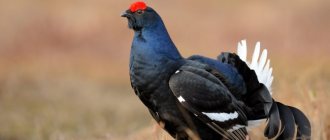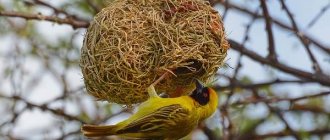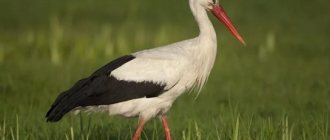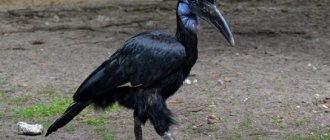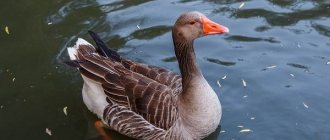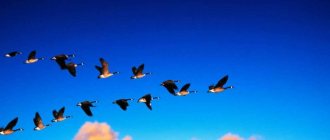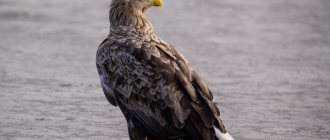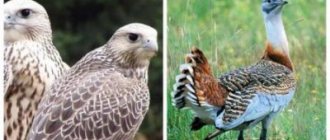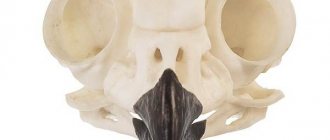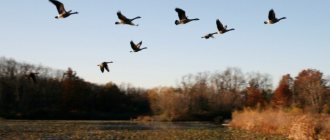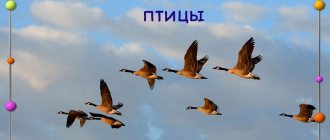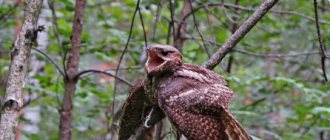Loons of Tatarstan
The order in the republic is represented by two species of the same loon family. Both are rare in Tatarstan. The Red-throated Loon is mainly found migrating. Breeds in the country:
Black-throated Loon
Externally, it is distinguished by a thick neck, the width of a loon’s head. The bird also has a straight, sharp beak and a seemingly sleek silhouette. The bird is approximately the size of a goose and reaches 73 centimeters in length. Some males weigh 3.4 kilograms.
The species is found on the Nizhnekamsk Reservoir. Like all loons, the bird is “attached” to water and comes to land only to incubate eggs. Walking on the ground is hindered by the legs shifted towards the tail. With these people you can only stand in a penguin pose.
Loons choose large, cool bodies of water
Grebe birds of the country
The order is represented by one family of grebes. The birds of Tatarstan include 5 species. One of them:
Great grebe
The second name of the bird is grebe. It reaches half a meter in length. Other toadstools are smaller. The bird has a long and thin neck, a pointed and straight beak, and an elongated head. The latter, in her wedding attire, is decorated with brown sideburns and a tuft on the top of her head. They give the toadstool's already large head additional volume.
It is small in number in the republic, but individuals are distributed throughout the region. The largest accumulations are observed in the bays of the Nizhnekamsk and Kuibyshev reservoirs.
In addition to the great grebe, Tatarstan is inhabited by the black-necked, red-necked, grey-cheeked and little grebe.
The great grebe is called the toadstool because of the unpleasant smell of its meat.
Dive behavior
These birds of Tatarstan live in flocks and can live with other representatives of the duck family. They are too clumsy when moving on land, so they spend most of their time in the water. Pochards dive and swim excellently. In case of danger, unlike other birds, they do not take off, but dive under the water, where they wait out the unfavorable time.
During molting, red-headed ducks cannot fly, so they prefer to spend this period with their relatives, away from places where they can become easy prey for predators or humans.
The birds' voice is very hoarse, reminiscent of croaking. The dive flies quickly, along a straight trajectory.
Copepods of Tatarstan
In the region, the order is represented by two families. We are talking about cormorants and pelicans. In the latter there are 2 species of birds, and cormorants - one and this:
Cormorant
The bird's body length reaches 95 centimeters. The weight is almost 3 kilos. Externally, the cormorant is distinguished by its black plumage. There is an orangeish patch on the long neck.
Until the 19th century, it was common in Tatarstan, nesting on the Volga and Kama. However, in the 21st century the species is extremely rare and is listed in the Red Book of the Republic and Russia. Single individuals are found on the Ushnya River and in the lower reaches of the Kama.
Pink Pelican
This is already a representative of the pelican family, found in the republic along with the curly species. Pink is so named because of the color of its feathers. They are of a gentle tone. The bird itself looks like a swan.
The only striking difference is the beak with a skin sac underneath it. In the latter, the pelican stores fish. The length of the beak reaches 47 centimeters. This is like tweezers for catching fish.
Only one individual of the pink pelican was observed in Tatarstan. The bird fed on the Belaya River, near the mouth.
Stork birds of Tatarstan
In the republic, the order includes birds of 3 families. Of the two, 2 species are represented in the republic. Another family on the lands of Tatarstan consists of 4 types of birds.
gray heron
Belongs to the heron family. The characteristic coloring consists of a contrasting combination of ash and black on the wings, and the same black crest on the head. The bird's beak and legs are red.
The gray heron is found in Tatarstan along with the great white heron, as well as the little and great bitterns. For almost 2 centuries the species has been common and widespread in the republic.
Karavayka
Among the storks, it belongs to the ibis family. All the birds in it are medium-sized and have long legs. The loaf is like that too. The head, neck and upper body of the bird are chestnut in color. Further, the plumage is brown. On the wings it is green and bronze. There is a metallic glow.
The birds of Tatarstan in the photo are usually “borrowed” from photographers from other regions. The loaf flew into the republic itself only twice. The last case was recorded in 1981. There was a second species of ibis in Tatarstan, once, in 1989. We're talking about spoonbill.
Karavaika is also called the sacred ibis
White stork
Migratory birds of Tatarstan of the stork family are larger than most birds of the republic. The body length of birds exceeds a meter. The stork's wingspan is more than 2 meters. The bird weighs 4 kilos. The stork's neck is thicker in comparison with the ibis or heron. The straight and long beak of the bird, like its legs, is colored red. The stork's body is white except for the flight feathers.
In Tatarstan, storks were seen in the Buinsky and Chistopol regions. There are also nesting sites on the border with the republic, in particular in the Ulyanovsk and Nizhny Novgorod regions. Another Tatarstan stork is found there - the black one.
Flamingobirds of Tatarstan
In the republic, the order is represented by a single species - the common flamingo. It belongs to the flamingodae family. The appearance of the bird is known to everyone. In the republic, flamingos sometimes fly by. Birds were seen alone and in small flocks. In Tatarstan, the species is endangered and is listed in the Red Book.
Birds of the Saratov region
The Saratov region is a unique place where many birds create nests. The entire avifauna of the region can be divided into three groups: diurnal predators, waterfowl and birds living near the water, and omnivorous representatives of passerines. The first group is represented by the family Accipitridae and Ospreys. The second is mostly duck and swan. Most representatives of the avifauna nest, but some winter here. In total, there are more than 330 species in the region, many of which live in fields or other open spaces.
Anseriformes of the republic
The Anseriformes order in Tatarstan is one, but numerous, family of Anatidae. Of these, 33 species live in the republic. Among them:
Common scoter
The largest among ducks, its length reaches 58 centimeters. The weight of the bird is 1.5 kilograms. Females of the species are brown, and males are black with white flight feathers and areas under the eyes. The scoter is also distinguished by its beak with a hump.
The scoter is easily recognized by the hump on its nose
In addition to the scoter, the duck birds of the Republic of Tatarstan are represented by black, barnacle and red-breasted geese, greylag and white geese, bean goose, lesser lesser white-fronted lesser white-fronted lesser white-fronted lesser ducks, whooper and mute swans, gorse, grebe and mallard.
Barnacle Goose
The list also includes teal, waders, gadwalls, wigeons, pintails, shovelers, sea ducks, blackheads, tufted ducks and white-eyed ducks.
Pintail duck
It remains to mention the sailor, the common goldeneye, the white-headed duck, the blue fin, the common eider, the lutka, the longnose and the great merganser.
Great merganser
Geese breeding
These are birds that create permanent pairs. During the breeding season, which begins in June and lasts for three months, they beautifully look after each other. This is a special ritual consisting of a strange dance, with a constant change of poses.
Black geese nest in groups, which allows them to protect themselves from various predators, such as gulls, arctic foxes and polar bears. A nest is built in depressions in the ground along bodies of water with good vegetation. The bottom is covered with down and soft grass.
The female can lay from three to five eggs and incubates them for twenty-four days (on average). The male is nearby all the time, he cares for his wife and helps in raising the ducklings. The babies are able to leave the nest within a few hours. Parents lead their brood to bodies of water and teach them how to get food. For six weeks, the couple protects their ducklings, and then the grown-up offspring can leave the shelter on their own, but remain with their parents until other babies appear.
Falconiformes of the Republic
All birds on the list are birds of prey of Tatarstan . There are 31 species in the order. These are 3 families. The osprey family is represented by only one species. This:
Osprey
Its back and tail are brown, and the rest of its plumage is white except for brown stripes running from the eyes to the sides of the neck. The bird weighs about 2 kilos and reaches 60 centimeters in length.
In Tatarstan and in the world in general, the osprey is extremely rare. The bird is listed in the International Red Book. About 10 pairs of ospreys were counted throughout Tatarstan.
Black kite
Belongs to the hawk family. The bird is completely brown. The plumage goes down to the shins of the legs. They are not long. The bird's body is also small. The tail and wings seem disproportionately long against its background.
The black kite is typical for Tatarstan and widespread. There are especially many birds in river valleys, for example, in the Zakamsky districts.
Accipitridae of the order Falconiformes in Tatarstan also include the common buzzard, marsh, steppe, meadow and field harriers, sparrowhawk and goshawk, rough-legged buzzard, buzzard and European turik, and black vulture. It remains to add the snake eagle, common buzzard, dwarf eagle, white-tailed and steppe eagle, lesser and greater spotted eagles, imperial eagle, and golden eagle.
In the photo there is a Rough-legged Eagle
Griffon Vulture
Represents the third family of the order - falcons. The bird looks like a black vulture. The difference is the light coloring, which combines a brown body and a white head. In addition, the bird is slimmer and smaller than the black vulture. The body length of the white-headed animal does not exceed 115 centimeters. The weight of the bird reaches 12 kilos.
Griffon vultures are birds of prey of Tatarstan , found on migration in the southeastern regions of the region. However, stopping birds in the republic is a bad sign. Barn owls are scavengers and fly during years of livestock loss and epidemics.
Galliformes of Tatarstan
The order is represented by two families. There are dozens of species, but only 6 nest in the region. Examples are:
Ptarmigan
The bird of the grouse family is densely built, has short legs and a short beak. The beak is slightly curved down. The paws are feathered, saving them from frost. The white partridge inhabits regions with harsh climates. The color of the plumage helps to camouflage against the background of snow.
Being a native of the north, the partridge reaches Tatarstan on migration and is rare in the republic. Birds have been seen in the Volga and Predkamsky regions. Black grouse, capercaillie and hazel grouse are more common in Tatarstan.
The paws of the white partridge are covered with feathers, which helps the bird survive the frost
Quail
Together with the gray partridge, it represents birds of the pheasant family in the republic. Quail is the smallest among chickens, weighing about 130 grams and not exceeding 20 centimeters in length.
Quail is a common bird in the fields and meadows of the republic. Most representatives of the species are in the far east of the region.
Breeding offspring
Black kites arrive for nesting in April from Southern countries, when the snow has not yet melted in some places. They can be found not only in the forest, but also near urban settlements; sometimes they can fly into a quiet city.
Nests are made independently, or those abandoned by other birds and suitable in size are populated. Usually the diameter of the nest does not exceed a meter, and they are considered modest given the size of the birds themselves. The dwelling is located on a tree or rock, located at a height of up to fifteen meters from the ground. Nests are insulated with feathers, paper, down and grass.
The female lays eggs in early May, usually two or three future chicks. There may be four eggs in a clutch; in very rare cases, five appear. The size is slightly larger than a matchbox, the color is white, with a barely noticeable blue tint. The shell is decorated with brown spots.
The eggs take up to one and a half months to hatch, and the parents share all the worries. After hatching, the chicks do not leave the nest until forty-five days, after which they can fly independently. Sexual maturity in this species occurs at the age of two. In nature, birds can live up to 25 years.
Crane-like birds of Tatarstan
There are 3 families in the detachment. The smallest number is the cranes. It is represented by one type:
Gray crane
It lives up to its name because it is completely gray. In some places the color is almost black, particularly on the bird's flight feathers. Together with its long legs and neck, the height of the crane is 130 centimeters. Large males weigh 7 kilograms.
Gray cranes are birds in the Red Book of Tatarstan . You can meet birds in remote forest swamps and floodplains. In particular, cranes are found in the Volga Valley.
Small Crake
Among the crane-like animals, it belongs to the rail family. The bird is miniature. Body length is 20 centimeters. However, long legs with outstretched toes add scale. The bird has pointed wings and a tail. The beak of the small crake is sharp.
The small one also differs from other crakes in its slenderness. The family also includes rail, corncrake, moorhen, coot and crake.
Little Bustard
Represents the Bustard family. The bustard itself also nests in Tatarstan. The little bustard has yellow legs, orange eye rims and a beak of the same color. The bird's neck is black and white. The little bustard's belly is light, and the rest of its plumage is brownish. The bird is 44 centimeters long and weighs about a kilogram.
Little bustard is found in the steppes of Tatarstan, but rarely. The species is considered vagrant.
Charadriiformes of the Republic
Extensive squad. There are 8 families represented in the republic. In other words, there are actually 7 of them. The representative of the avdotaceae, the avdotka, is extremely rare on the lands of the region; it is a migratory species. The remaining families represent:
Lapwing
The size is comparable to the lapwing, but it has a crest, and the bird’s head is miniature. The lapwing is large and without a crest. There are dark spots on the bird's bluish plumage.
The Lapwing lives in the steppes of southern Tatarstan. Birds fly there. The republic is not a permanent nesting site for lapwings.
The lapwing belongs to the plovers. From the family in Tatarstan there are also: tules, little plover, ringed plover, snapper, lapwing, golden plover and turnstone.
Avocet
In the order Charadriiformes it is included in the avocet family. There are no more representatives of it in the republic. The name of the birds of Tatarstan is due to the shape of their beak. It is approximately 7 centimeters long, thin and pointed at the upward curved end.
The beak, like the top of the head, neck and area under the wings of the bird, is black. The feathered legs are bluish-blue and long, as is the neck. The avocet's tail is short.
The body length of the avocet is a maximum of 45 centimeters. The body weight of the bird is 450 grams.
Oystercatcher
The only species of the oystercatcher family in the republic. The bird is about the size of a crow and has a long, strong beak. It is straight and red. The sandpiper itself is black and white. The feathered legs are the color of the beak, but short.
Among the lands of Tatarstan, the oystercatcher chose the Kama region. In the 20th century, the bird was typical for the republic and widespread. Now the number of the species is declining, which became the reason for the inclusion of the sandpiper in the Red Book of the region.
Woodcock
Among Charadriiformes, it is considered a member of the snipe family. The woodcock is large, tightly built, and has a straight, long and strong beak. The color of the bird is variegated in brown-red tones. On each wing of the animal there is one picturesque feather. Painters draw the thinnest lines this way. They are often depicted on icons, cigarette cases, and boxes.
The picturesque feather of a woodcock is an elastic wedge. Its length does not exceed 2 centimeters. The wedge has a sharp edge. That's what they paint with.
Woodcock is a typical inhabitant of Tatarstan swamps
In addition to the woodcock, which is typical and widespread in Tatarstan, other snipes are also found in the region. There are 27 of them. Examples are: Greater and Lesser Godwits, Greater and Middle Curlew, Great Snipe, Mudwing, Icelandic and Little Sandpipers, Dunlin. Most of them are in the republic on a flight.
Steppe Tirkushka
The only representative of the Tirkushev family in the republic. The bird is similar to the meadow tirkushka, but instead of chestnut coverts it has black and larger feathers. The weight of males reaches 105 grams. There is also no white line on the trailing edge of the wing of the steppe species.
In Tatarstan, the steppe tirkushka is considered a vagrant and rare. The last time the bird was seen was at the turn of the century in the Verkhne-Uslonsky region.
Short-tailed Skua
In the order Charadriiformes it is classified in the skuas family. The short-tailed one is the most common one. The bird is the size of a blue gull. In appearance, the pointed tail feathers protruding beyond its edge stand out. The protrusion reaches 14 centimeters.
In addition to the short-tailed skua, the common skua is also found in Tatarstan. It has a more curved beak and a larger head. The species is rare and vagrant for the republic.
Eastern clownfish
Bird of the gull family. The bird is colored grey. If compared with the herring gull, the color is darker, and if compared with the common black gull, it is lighter. The length of the animal is also average, reaching 48 centimeters. The weight of the eastern black salmon varies from 750 to 1350 grams.
The eastern black-billed gull is distributed throughout all ponds, reservoirs, rivers and lakes of Tatarstan, which cannot be said about most other gulls in the region: the black-headed laughing gull, the little and herring gulls, the sea pigeon, and the glaucous gull. There are 16 representatives of the family in the region.
Appearance
An adult pochard has an average body size of 58 centimeters. The weight can reach from 0.7 to 1.1 kilograms. It has a neat short tail; its distinctive feature is its arched back when swimming. The duck's neck is short and its body is dense. The bird's legs are located far behind, so when it stands, it leans forward strongly.
The beak of this duck is equal to the length of the head, it is slightly widened at the base. The plumage of the wings and body has a typical color, a gray-white pattern is clearly visible.
An adult female is quite easy to distinguish from a male. They have different patterns and head colors. In the male it is colored brown-red, and in the female it is yellow-brown.
Pigeon-like birds of the republic
Represented by two families. The total number of species found in Tatarstan is 6. Among them:
Saja
Represents the family of sandgrouse. There are no more birds classified as this in the region. Saji have elongated central tail feathers. They are slightly curved, hanging down like threads. There is no back toe on the animal’s feet, and the front toes are partially fused into a single sole.
The wide and blunt claws on it are like hooves. Plus, the Saji's legs are fully feathered. It seems that you are looking at the paw of a hare, not a bird.
Sadzhu has not been seen in Tatarstan since the beginning of the last century.
Rock pigeon
Represents the pigeon family. Among them, the species is the most numerous. On the lands of the republic, domestic and semi-wild forms of the rock pigeon are found.
In addition to the gray species, the republic is inhabited by such pigeons as: great, common and ringed doves, wood pigeon, and clint.
Cuckoobirds of the region
The order in the republic is represented by one family and two species of birds. One of them:
Common cuckoo
Belongs to the cuckoo family. The bird has a short tail and narrow wings. The top of the cuckoo's body is usually gray. However, sometimes reddish birds are found.
In addition to the common cuckoo, the deaf cuckoo is also found on the lands of Tatarstan. She is named so because of her muffled voice. Even the feathered one is smaller than usual.
Owl birds of Tatarstan
The order in the region is represented by one large family of owls. Among its types:
Great-tailed owl
This is an owl the size of a chicken. The large and rounded head has a pronounced facial disc. The bird is distinguished by its long tail. Otherwise the animal is similar to the smaller gray owl. The brown color of the plumage is more pronounced than that of the long-tailed one.
The owl family in the region is also represented by: great gray and gray owls, great, long-eared, white, marsh and hawk owls, scops owl, eagle owl, woolly, house and sparrow owls. All of them are forest birds of Tatarstan .
Owl squad
Birds of this order are distinguished by their nocturnal life. A large movable head with a facial disc will not allow them to be confused with other inhabitants of the feathered world. Males are usually smaller than females. The diet of these nocturnal inhabitants includes warm-blooded animals, most often mice and voles. Owls are not too concerned with building cozy nests. They simply lay their eggs on the ground or in thickets of grass. Sometimes they occupy other people's nests. Males do not participate in the incubation process. The fauna of Tatarstan includes 12 species of owls.
Owl
A large representative of the feathered world, weighing up to 3 kg. Can be found everywhere, but prefers to live in the dense thickets of the taiga.
Long eared owl
Another common species, living throughout the territory. You can see long-eared owls even on the outskirts of the city. In adulthood, they reach a maximum weight of only 500 g. From 3 to 8 owlets are raised at a time.
Nightjar birds of the republic
In Tatarstan, the order is represented by the only species of the goat family. This:
Common nightjar
It has long wings and a tail. But the legs and beak of the bird are short. The head of the nightjar is flattened, like a chizhina. The tip of the bird's beak is curved down, and the mouth opening is wide and crowned at the edges with antennae feathers. The nightjar also has large, bulging brown eyes.
For two centuries of ornithological research, the common nightjar was widespread in Tatarstan. By the 21st century, the species' numbers had declined sharply. The bird is included in the Red Book of the Republic.
Swift birds of Tatarstan
On the territory of the region, the order is represented by one species of the swift family and this is:
Black swift
The only representative of the swift family in the republic. The bird, as the name suggests, is black. The swift is larger in size than a swallow and, like it, does not use sharp throws or changes in flight.
The black swift is numerous in Tatarstan. The status is relevant throughout the 2-century observation of the species in the republic.
Roller
Resembles and is the size of a jay. The bird belongs to the roller family. There are no more representatives of it in Tatarstan. The roller is stocky. The bird has a large head and a large, strong beak. The tail is shorter than that of the jay, and the wings are longer. The color of the roller combines chestnut, black, blue, and light blue.
Tatarstan is the northern border of the roller nesting. It settles in the forest-steppe zone of the south of the republic.
Common kingfisher
Belongs to the kingfishers. The bird has a compact body, a large head, and a sharp and long beak. The picture is complemented by orange-turquoise plumage.
The common kingfisher nests throughout Tatarstan, but the number of the species is small.
Kingfisher little fish lover
European bee-eater
In the order of swift-shaped animals, it represents the bee-eater family. The bird has an elongated body and iridescent coloring. The latter combines yellow, green, orange, blue, black, and brick colors.
The golden bee-eater weighs approximately 50 grams. In Tatarstan, the birds migrate and sometimes nest.
Squad of seagulls
In the vastness of the republic, 12 species of gulls have been recorded, and 4 of them are only migratory during migrations. The population can be divided into 4 groups:
- seagulls. These are birds of a silvery-white color;
- river terns. It can be recognized by a noticeable notch on the tail, a black spot on the head and sharp wings;
- marsh terns. The birds are small in size (up to 70 g), dark in color interspersed with white feathers;
- skuas. Rarely found in this region. They can be distinguished by the elongated feathers in the middle of the tail, similar to a spire, and the dark color of the carcass.
Seagulls lay three eggs, after which both parents actively participate in hatching and caring for the hatched chicks.
Common gull
They arrive at the very beginning of April. Towards the end of spring, they gather in huge flocks and begin nesting. They feed on fish, frogs, and rodents.
Common tern
They live in large numbers on river shallows and islands. They nest in colonies of 10-15 pairs. The basis of their diet consists of small fish and crustaceans. They arrive in the last numbers, and closer to autumn they leave Tatarstan again.
Woodpecker birds of the republic
The order is represented by one family of woodpeckers. In the region, it includes 8 species of birds, including:
Lesser Woodpecker
The smallest woodpecker in Europe. The bird weighs no more than 25 grams. The plumage of the Lesser Woodpecker is black and white with light transverse lines on the back of the bird.
Lesser woodpeckers roam the territory of Tatarstan; they are typical for the region and nest there every year. Birds of this species often fly into cities, choosing areas with tree plantations.
In addition to the small birds, the woodpecker family in the region includes: gray-haired, green, motley, white-backed and three-toed woodpeckers, yellow woodpeckers, and whirly-necked woodpeckers.
Classification of wintering birds
Birds that do not leave their permanent habitat with the onset of the cold season are called wintering birds. They are classified according to different criteria.
By territorial basis:
- forest;
- field;
- urban.
By method of obtaining food:
- omnivores;
- predatory;
- herbivores.
City birds in winter
It is difficult to list all the birds that remain over the winter; below we will consider the main representatives of birds that remain with us in winter.
Difference from migratory
Before moving on to looking at pictures with the names of wintering birds, you need to understand how birds remaining for the winter differ from migratory birds.
Important differences:
- know how to build nests for themselves;
- find food even in winter;
- can live next to a person in cities;
- don't freeze in the cold.
These are just a few differences that make it possible to determine whether a bird winters or flies south.
Birds wintering in the forest
Why don't they fly south?
Most of the birds remain in their place because they are accustomed to a sedentary life and know how to get food for themselves even in difficult conditions.
Most often, predators winter and those birds that feed on winter berries, cones, seeds, and make supplies for themselves. They do not need to fly away to get food again.
Birds that are heavy and slow do not fly south and are not able to fly long distances. For example, hazel grouse and black grouse.
What helps you survive the winter
Before we move on to listing the names of wintering birds for children, let's figure out what will help birds survive in the harsh winter? Of course, the ability to get food in difficult conditions and build warm shelters.
Bird feeders
To help birds survive the winter, you can do the following:
- make and hang a feeder on a tree where birds can feed;
- add food in a timely manner - grain seeds, heat-treated lard (not salted), unroasted sunflower seeds, rowan berries, cones, acorns, ready-made food, fruit slices;
- hang the feeder away from windows and balconies, preferably on a tree in a square or park.
Such assistance will be useful for wintering birds, it will help them feed themselves and not freeze even in the coldest winter.
Passerine birds of Tatarstan
The largest order in the region is represented by 21 families and 113 species of birds. Here are some examples:
Voronok
Represents the swallow family. The funnel is black on the back with white fragments below the body. The bird weighs about 20 grams and flies without sharp turns, characteristic, for example, of the barn swallow. It also nests in the region.
The swallow species in Tatarstan also includes a coastal species. It is numerous throughout the republic.
wood lark
This is a bird of the lark family. The bird is the size of a sparrow and is also colored brown. On the animal's head, the feathers rise, forming a crest. This is a feature of all larks. They differ in nuances. From the field, for example, the forest one differs in its shortened tail.
In Tatarstan, the wood lark is found in the Volga and Kama valleys. The species is rare, listed in the Red Book of the Republic.
Other larks found in the region include crested, black, white-winged and horned larks.
Yellow wagtail
Represents the wagtail family. The bird resembles a white wagtail, but with a shortened tail. The white species does not live in Tatarstan. The yellow wagtail is common in the region and nests annually.
Among the wagtail birds of Tatarstan there are also: forest, spotted, meadow, red-breasted and field pipits, black-headed, yellow-fronted, mountain, white and yellow-headed wagtails.
White wagtail
Common Shrike
Belongs to the shrikes. The bird has a head that is compressed from the sides, a long tail, and a color made up of white, red, black, brown and gray.
Of the shrikes, of which there are 3 species in the republic, the common one is the most common and numerous.
Pastor
Along with the common starling, it represents the starling family in Tatarstan. The pink species differs from the standard one in having a short beak and smaller size. The body of the bird is painted pink, the head, chest and wings are black and purple. The crest on the starling's head is the same color.
In Tatarstan, the pink starling is found extremely rarely, only in flight. As a rule, birds fly in to profit from locusts during the years of their massive invasion on the lands of the republic.
Jackdaw
The jackdaw is slate-black with a gray head, tightly built, and reaches a length of 34 centimeters. The bird weighs no more than 20 grams and belongs to the corvid family.
In Tatarstan, the jackdaw is common. Some birds remain in the region for the winter. Other jackdaws fly to warmer climes in the cold weather.
There are 9 species of corvids in the region. In addition to the jackdaw, these are: hooded and black crows, rook, raven, magpie, nutcracker, jay and cuckoo.
nightingale cricket
The size of the bird is indeed close to a cricket, weighing approximately 11 grams. The body length of the bird is 14 centimeters. The back of the cricket is reddish, and the underside of the body is beige.
Nightingale crickets are songbirds of Tatarstan . The trill of birds is chirpy, but sounds soft.
The nightingale cricket in the order Passeriformes is a representative of the warbler family. The following are also found in the republic: river, spotted and common crickets, Indian, aquatic, garden, marsh, reed, blackbird and badger warblers, several warblers and warblers.
Little flycatcher
Representatives of the species are listed among the flycatchers. Small birds are smaller than other members of the family. The birds are compact and have short beaks. The wings and tail of the small flycatcher are also short. The animal is about a third smaller than a sparrow.
Small flycatchers nest in the Trans-Kama region and the Volga region of Tatarstan and are considered a common, numerous species.
In addition to the small flycatcher, grey, mottled and white-necked flycatchers nest in the region.
Black-headed Chickadee
In the order of passerine birds, it represents the tit family. The chickadee weighs 10 grams. The bird is completely dark, but the head is almost black, and the color of the breast is a couple of shades lighter than the color of the back. This distinguishes a nut from a powder. There is no clear boundary between the color of the top and bottom of the body.
The black-headed chickadee is a sedentary bird species that spends all year round in Tatarstan. In the eastern territories of the region, birds are rare, but in other areas they are numerous.
In Tatarstan, not only Russian is spoken. Each bird has a Tatar name. A goose, for example, is called kaz. In Tatar, golden eagle is berkert, and rook is kara hag. Swans in the region are called akkoshas. Owl in Tatar is yabolak.
Birds of Tatarstan educational and methodological material (middle group) on the topic
Birds of Tatarstan
Many migratory birds nest in Tataria and live here temporarily.
As among animals, among birds there is also mutual penetration of forest and steppe. The three-toed woodpecker, black grouse, wood grouse, eagle owl, long-eared owl, tawny owl and hazel grouse are coexisted with the black swift, gray and white partridge, bustard and lark - field and forest.
There are numerous inhabitants of the reservoirs: black-headed gull, black-headed gull, common tern, as well as swans, geese, ducks, pochards and mergansers.
Birds of prey feel like kings of the air: the peregrine falcon, hawk, common buzzard, tuvik, griffon vulture, black vulture, steppe eagle, golden eagle, kite, marsh harrier and others - 28 species in total.
three-toed woodpecker
Three-toed woodpecker or yellow-headed woodpecker
Prefers oppressed, often swampy areas of the forest. It differs from other woodpeckers in the region by its lemon-yellow rather than red cap of feathers on its head.
It nests in pairs; during the rest of the year it leads a solitary lifestyle. The usual call made throughout the year is a soft "bale" or "tick" - lower than that of the Great Spotted Woodpecker
It feeds on insects, mainly larvae and pupae of xylophages. Among the beetles, bark beetles and longhorned beetles predominate; to a lesser extent, they feed on leaf beetles, golden beetles, weevils, ground beetles, pied beetles, narrow beetles and some others. Sometimes it eats ants, spiders, stoneflies, grasshoppers, flies, bees, even mollusks.
From plant foods it feeds on tree sap and occasionally eats rowan berries. Doesn't break the cones. The clutch contains 3-6 (rarely 7) oblong white eggs with a smooth shiny shell. Incubation from the last egg; Both birds sit, changing 5-6 times a day. However, during the dark time of day, only the male is in the nest. Naked and helpless chicks are born synchronously 11-14 days after the start of incubation. They are fed by both parents in turn, regurgitating the food they bring from beak to beak. Usually quiet and inconspicuous, after the birth of their offspring, woodpeckers become restless and noisier; the grown offspring screams, leaning out of the nest. At the age of 22-26 days, the chicks leave the nest and begin to flutter around, but for about another month they stay near their parents, after which they finally disperse.
LAKE GULL
Slightly smaller in size than a crow, and weighing as much as a pigeon. In breeding plumage the head is dark brown and appears black from afar. The mantle is light gray. The beak and legs are dark red. It differs from the little gull in size; in addition, the dark plumage on the head does not cover the back of the head,
the lower surface of the wing is not black, only the ends of the wings are dark. In autumn plumage, only the “earring” remains dark on the head and there may still be small “blots”. In juveniles, the main color of the upperparts is brown and reddish-brown and very variegated, the tail has a dark brown
preapical stripe. Weight 200–320 g, length 38–44 CM. They nest in colonies of several to several thousand pairs.
They settle in a wide variety of inland waters, mainly in flat areas. They appear in the spring around the flood or shortly before it and are soon concentrated in colonies, many of which exist for decades, others for only one or two seasons, depending on the conservation of the habitat itself. Some birds arrive from the south already in pairs, other pairs form on the colony and in its environs. Most adult birds return to the colony annually, but some move to other, neighboring, or more remote areas.
The nest is built by the male and female together from various plant materials, mostly from damp and soft, partially rotted grass. On high hummocks the nest may be very small, just a hole with a dry lining. There are nests almost 1 m in diameter and up to 30–40 cm high. The clutch contains from 1 to 3, most often 3 eggs. There are 4 or more eggs, but these are most likely double clutches. The color of the eggs is very variable - from light blue or creamy white with almost no pattern to dark brown, with continuous spots, most often greenish or olive-brown or greenish-ochre, with various spots of different shades of brown. Egg dimensions are 41–69 x 30–40 mm. The male and female incubate. When there is danger, a commotion arises in the colony, the seagulls scream, circle, dive, and splash the trespasser with droppings. Birds of prey and crows are attacked and driven away. However, nests are destroyed by both aerial and ground predators. In such cases, repeated layings are very common. Incubation duration is 22–26 days. The chicks stay within or around the colony and begin to fly at 25–30 days of age. Soon after this they leave the colonies and wander widely. In the north, this period is very short and quickly turns into departure. The last birds fly away in late autumn. They migrate in flocks, forming an irregular wide wedge, chain, arc, wavy line or other linear formation. The food is very diverse - worms, insects and other invertebrates, collected both on water and on land, most often in fields. All kinds of waste play a significant role, especially in spring and autumn, when many birds gather in landfills. They peck at sick and dead fish, catch fry, and catch small rodents. They readily eat berries and seeds. The maximum known life expectancy is 32 years.
GROUSE
The hazel grouse is the smallest representative of the grouse. The weight of even the largest individuals rarely exceeds 500 grams.
In the forest it is difficult to confuse it with other grouse birds, from which it differs not only in its small size, but also in its fairly recognizable color. Despite the motley, “pockmarked” plumage (from which the bird got its Russian name), already from a short distance the hazel grouse appears monochromatic, gray-reddish. It is a sedentary bird that does not make long migrations. The hazel grouse, like all grouse, is mainly herbivorous, although in summer animal food takes up a significant place in its diet; The chicks feed mainly on insects. In winter, the hazel grouse is forced to content itself with coarse and low-nutrient plant food. If there is snow cover, hazel grouse burrow into the snow in winter, spending the night and the coldest hours of the day in it. This also provides some protection from predators, from which the hazel grouse suffers greatly both in winter and summer.
Despite the decline in the world population and the periodic decline in the numbers of individual populations, the hazel grouse is still numerous and is not in danger of extinction.
A small, jackdaw-sized, plump bird with a disproportionately small head and a short beak. He spends most of his time on the ground, where he leads a secretive lifestyle.
When a person approaches, it runs away or hides. Taken by surprise, it flies away 40-80 m and sits on a coniferous tree branch closer to the trunk at a height of at least 5-7 m, trying to merge with it
This is a rather silent bird. The main vocal signal is a long and very thin whistle. The nature of the sound pattern is somewhat different between the sexes; in males it is conveyed as “fuiiiit, fuiiiit, fuIt-ti-ti-te-ti.” When performing a song, the male throws his head back and opens his beak wide. The female's singing is shorter and simpler
OWL
A large bird of prey, smaller in size than the golden eagle, but slightly larger than the white owl. According to Russian sources, the length of the bird is 60-75 cm, the wingspan is 160-190 cm, the weight of males is 2.1-2.7 kg, the weight of females is 3.0-3.2 kg. The elongated feathers of the head sticking out on the sides, which many mistakenly mistake for ears, help the bird to blend into its environment during the daytime rest. The general physique of the eagle owl is stocky, almost “barrel-shaped”. The plumage is soft and loose, which contributes to silent flight. In the variegated colors, red and ocher tones stand out well, but the overall color tone is subject to significant variability in different parts of the range. It varies from rusty and brownish black to greyish ocher and cream. Eagle owl has a powerful voice and a complex repertoire. Among other things, the vocalization of this bird is subject to individual variability, as a result of which its functional purpose is not always clear. Most often, the presence of a bird nearby is indicated by its low two-syllable hoot with an emphasis on the first syllable, which in calm weather can be heard at a distance of up to 2-4 km. In most cases, a male hoots like this when he wants to get to know a female, although females are also capable of making such sounds, only lower ones. Sometimes you can hear the calls of both birds (when they like each other) turning into a continuous hum.
The eagle owl's signal of concern is a quick, energetic laugh consisting of four to five syllables. The sounds produced also include “crying,” humming, and mournful cries.
The eagle owl is not afraid of humans, although the biotopes it chooses are in most cases located away from populated areas and roads. Occasionally, the bird still settles on farms and even park areas of large cities
It is primarily a nocturnal hunter, although on a winter or cloudy day it can fly out in search of food during daylight hours. Having noticed a potential victim, the predator throws a stone at it and digs its claws in. After the fish, it dives completely or partially into the water. They love rodents very much.
EAR OWL
It is distinguished by large ear tufts consisting of 6 feathers, a shorter first flight feather (shorter than the fourth) and coloring. The general color tone is the same, gray-brown with variegated spots and a white breast, but the dark spots on the upper side of the body do not merge into longitudinal stripes, like the short-eared owl, and the rod spots on the underside of the body are elongated in the transverse direction, so that in general they form 4-6 fairly clear transverse stripes.
The common long-eared owl lives exclusively in forests, preferring coniferous forests to black forests, since here it is less noticeable in its color.
It nests mainly in old nests of corvids such as crows and magpies. The nest is usually located quite high, but there are known cases of nests being found at a height of only 1.5-2 meters. The clutch (at the end of March and April) usually consists of 4-5 spherical white eggs. Its main food consists of small rodents, mainly mice and voles, also insects, and birds during nesting. A medium-sized owl, reaching 31–37 cm in length and 86–98 cm in wingspan.
The long-eared owl can turn its head 210 degrees!
MARTLET
The black swift reaches a length of 18 cm, a wingspan of 40 cm, a wing length of 17 cm and a tail of 8 cm. The tail is forked, the plumage is dark brown with a greenish metallic tint, and the shape of the swift is similar to a swallow. The chin and throat are decorated with a rounded white spot; the eyes are dark brown, the beak is black, the legs are light brown. The plumage of males and females is no different, but the chicks are slightly lighter than adult swifts, and their feathers have off-white edges at the ends. In summer, the feathers fade significantly and the overall color becomes lighter.
The black swift has the highest horizontal flight speed among birds, reaching 111 km/h[2].
Since usually all four toes on the paws are directed in one direction, they cannot create the necessary support to maintain balance, so the black swift, like most other swifts, cannot move on the ground. As a result, if for some reason the birds fall to the ground (which happens only in exceptional cases) and the ability to fly is lost, they find themselves completely helpless.
Swifts living in the Russian Federation are a migratory species. In spring they appear quite late, after warm weather sets in, when a mass of flying insects appears. Since swifts are a very common bird species, city residents often encounter them during the “swift problem” - their chicks often fly away from the nest prematurely, not yet able to fly. This behavior is more likely to occur during rainy weather. At this time, people find them on the streets of populated areas. This phenomenon occurs in many other birds, but most bird species continue to care for their young. But if the chicks of other bird species are fed by their parents during the fledgling period, then in swifts the fledglings that fly out of the nest begin to feed on their own. In many countries, there are rehabilitation centers for such swifts, where they are rehabilitated and released back into the wild. Also, some enthusiasts feed these shears on their own. Black swifts arrive from wintering grounds in small flocks. After arrival, the black swift begins building a nest, which lasts about 8 days. 2-3 eggs are laid in the nest. During the year, the bird makes 1 clutch. The male and female incubate the chicks for 11-16 days. Small swifts stay in the nest for quite a long time and fly away from it on the 38-39th day, and sometimes, due to natural changes, on the 56th. Immediately after leaving the nest, they can fly and feed on their own.
It nests in colonies, making nests in hollows, rock cracks, in burrows along cliffs, under roofs, in crevices of buildings.
PARTRIDGE
Partridges (lat. Perdix) are a genus of the partridge subfamily (lat. Perdicinae), the pheasant family.
Representatives of the genus are medium-sized partridges. The beak and legs are dark in color. The upper part of the plumage is speckled, brown, the sides and tail are red. There are no spurs on the legs.
The differences between females and males boil down only to the fact that females are paler in color. They are sedentary birds and live in open areas.
They feed on a variety of seeds and sometimes insects.
Nests are made on the ground in the form of lined depressions located in secluded places.
This genus is divided into three species:
- Gray partridge
- bearded partridge
- Tibetan partridge
FOREST LARK
The wood lark is a small bird of brown color with dark longitudinal streaks, the underside, eyebrow and stripes on the sides of the tail and eyebrow are buffy-white, the chest is plain with brown spots on the sides. There is a small crest on the head. Often perches on trees, which is not typical for most larks. The voice is a ringing trill “tuyu-lyulyu” or “lyululyu”, often sings in the air, flying in circles. The name “Yula” comes from his song “Yuli-Yuli-Yuli” or “Yul-Yul-Yul”. It feeds on insects and seeds. It nests on the ground, in a hole under wormwood or cereals. The clutch contains 4-5 white or pinkish-brown eggs with brown spots.
LARK
The skylark is a small bird of the lark family. This small bird is known for its rather loud and melodious singing. The skylark is slightly larger in size than a sparrow and has a dull but attractive plumage color. Its back is gray, sometimes brownish-yellow with variegated patches, its belly plumage is white, its chest, quite wide for an elegant bird, has mottled brown feathers. The tarsus is light brown. The head of a skylark, neat and more refined than the head of a sparrow, is decorated with a small crest, the tail is bordered by white feathers. Above the dark eyes is a light eyebrow. The skylark's coloration is protective; it helps it camouflage itself in the grass and on the ground. The male can be distinguished from the female by its larger size and by its song, which is absent in the female.
The skylark is a true inhabitant of meadows and steppes, mountains and fields. The only place where you won’t find this little bird is the forest. After wintering, skylarks fly to the nesting site in early spring, when there are still no insects for food, they stay in small flocks in areas warmed by the sun, and hide from the wind and rain on the edges. Skylarks feed on plant food in the form of seeds of various grasses and cereal plants. Their diet includes seeds of bird buckwheat, pickle grass, and sparrow. These birds have a special passion for bristlecone seeds and other wild species of millet. When cultivated cereals ripen, larks happily raid fields sown with oats and wheat. Rye and barley are not as popular with them, as they are more oily, and skylarks prefer mealy foods. In order for hard cereal grains to be better digested in the stomach, they, along with the seeds, peck small pebbles. Arriving in early spring, when crops are just beginning to sprout, larks use them as food, replenishing the body with vitamin food. As soon as the snow melts and the sun begins to warm up, various insects appear that replenish the diet of skylarks. Small bugs, spiders, larvae of various insects, butterfly pupae - these insects constitute the main food of larks all summer. This bird always hunts on the ground and does not catch insects in flight or those that crawl high on plant stems. They satisfy their need for water with dew, which settles on the plants. You can often see skylarks bathing in dust or sand; they love such places and constantly return to them to clean their plumage. Being a field bird, the lark nests in meadows and on grassy edges, but the best place for nesting for these birds is fields sown with winter and spring crops. The nest is very simple; it is built in a hole on the ground, among the grass. The skylark uses stems and roots of grass as building material; the inside of the nest is lined with soft wool collected from birds, horsehair and down. The nest is camouflaged very carefully and is difficult to detect. The height of the nest is about 50 mm, the female lays from 4 to 6 eggs, which are yellowish in color and covered with small brown specks. The egg size is about 23 x 17 mm. The nest is built in early May, when the first green shoots appear. The female incubates the eggs for two weeks, the chicks hatch blind, they are covered with a little down. They grow very quickly and leave the nest after 10 days, although they cannot fly yet. Only after a few weeks do little larks learn this art and begin to feed on their own. All the time until the chicks rise to the wing, they hide among the grass and stems of cereals, where they are almost impossible to notice; the plumage of young skylarks merges with the surrounding vegetation, turning the birds invisible. In June, the female can lay a second clutch, the chicks of which begin independent life in July. Both young and old individuals fly away for the winter starting in September. In mid-October, there is practically not a single bird left. Wintering takes place in southern Europe.
RIVER TERN
Body length - 31-35 cm, wing length - 25-29 cm, wingspan - 70-80 cm; birds weigh 97-175 g. This slender bird has a forked tail and a red beak with a black tip. The plumage is white or light gray, and the upper side of the head is painted deep black. Sometimes the forehead is light and the beak is black. The feet of the common tern are red. The screams sound like kik or kriee.
Common terns skillfully dive in search of food. Their prey consists mainly of small fish. They also feed on shellfish and insects. Common terns nest from May to August on the coasts of rocky and sandy islands with sparse vegetation. Nesting within the continent is quite rare. A male with a fish in his beak performs a courtship dance, trying to impress the female. In the nest, which is a grass-lined depression in the ground, the female lays from one to four eggs. Both parents incubate them until the chicks hatch. Common terns protect them by swooping down on predators from the air. 3-4 weeks after birth, the offspring begins to fly.
SWANS
The plumage of swans is either pure white, gray or black. Females and males are very difficult to distinguish externally. Swans are distinguished from geese by their longer necks, which allow them to search the bottom in search of food in deeper waters, as well as by their size, which makes them the largest aquatic birds. Their wingspan reaches two meters, and their weight can exceed 15 kg. The legs are quite short, which is why swans, when moving on the ground, give a somewhat clumsy impression. But they have very developed flight muscles, allowing them to cover thousands of kilometers during annual flights to and from.
The offspring are raised by both parents, who care for the cubs for 1-2 years after birth.
In modern taxonomy, swans are divided into seven species:
- Black swan *Black-necked swan *Mute swan
- Trumpeter Swan *American Swan
- Lesser swan *Whooper swan
For humans, swans represent beauty, romance, a symbol of rebirth, purity, nobility and wisdom, which is caused by their graceful body structure, the ability to fly and swim.
GEESE
Geese are distinguished by a beak that has a greater height at the base than it is wide, and ends in a nail with a sharp edge. There are small teeth along the edges of the beak. Geese are distinguished by a neck of medium length (longer than that of ducks, but shorter than that of swans), rather high legs attached closer to the middle of the body than in ducks, and a hard tubercle, or spur, on the bend of the wing.
Feathers and down are highly developed. Males are practically no different from females - the only difference is in the bone growth “hump” at the beginning of the beak at the bridge of the male’s nose, as well as in the slightly larger body size.
Many geese cackle or make muttering sounds and hiss when in danger or in irritation.
Geese live in meadows and marshy areas, some on the shores of the seas; walk and run well; They fly fast, but swim and dive worse than ducks. They are much less likely to be on the water than ducks and swans; they spend most of their lives on land. Geese usually fly to wintering and nesting grounds at night at high altitudes, quite quickly.
They feed almost exclusively on plant foods, mainly green parts of plants and seeds. With the help of a beak equipped with sharp teeth along the edges, they pinch grass, cereals, cabbage, and pick off leaves, berries, pods and ears of corn. In addition to plants, some species also eat small vertebrates and insects.
Geese live in pairs, and during migration they gather in large flocks. They nest in swamps, some in trees; the number of eggs is usually 6-12. The male does not take part in incubating the eggs; he protects the female, and when the chicks hatch, he walks nearby, protecting the whole family.
DUCKS
Ducks are birds of medium and small size with a relatively short neck and a tarsus covered in front with transverse scutes. The color of the plumage is varied; many species have a special “mirror” on the wing. Mallard - The most famous and widespread wild duck. The body length of the male is about 62 cm, the female is about 57 cm, the weight reaches 1-1.5 kg (in the fall, when the bird fattens up before the flight, its weight can reach 2 kg). The head and neck of the male are green, the crop and chest are brownish-brown, the back and ventral side of the body are gray with thin transverse spots. The color of the female is brown with darker spots, the ventral side is brownish-gray with longitudinal streaks. On the wing of the male and female there is a blue-violet “mirror”.
Partially migratory bird. Inhabits fresh and slightly brackish water bodies. In recent years, many birds have been wintering on ice-free reservoirs in large cities and their environs.
The usual voice is a quiet quack - “rab-rab-rab.” The female's voice is a quack, like that of a domestic duck. Instead of quacks, the male has a muted velvety sound “shaaaak” or “shyaaaark”. When frightened, the quack is longer, and before take-off it is quiet and hasty. The female’s voice in autumn and winter, calling the male, is a loud “kuak-kuak-kuak-kuak-kuak”.
It is very flexible in its choice of feed and easily adapts to local conditions. It feeds in shallow waters by filtration, filtering small aquatic animals and plant food through the horny plates of its beak. Feeds on plant foods (duckweed, hornwort, etc.), small invertebrates, insects, mollusks, small fish, crustaceans, tadpoles, even frogs
Often the mallard stands vertically in the water, with its tail up, trying to reach plants growing at the bottom of the reservoir. It feeds most often in shallow water with a depth of up to 30-35 cm, where it obtains food from the bottom, turning vertically upside down, but without diving.
In early spring, when reservoirs are still covered with ice, mallards stay in the ice holes. The diet at this time is based on overwintered green parts of aquatic plants. In winter, the amount of animal feed in the mallard's diet is sharply reduced. In the first half of winter, they feed mainly on shoots of aquatic plants and seeds. On city ponds and other artificial reservoirs, mallards are very numerous, they completely get used to people and live primarily by feeding
